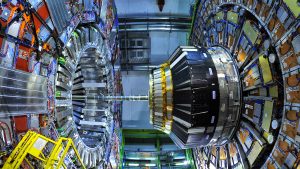Researchers from FAU Erlangen-Nürnberg have succeeded in developing the first nanophotonic electron accelerator.
Particle accelerators are used in a variety of industries, such as research and the medical sector. These machines require large amounts of space ranging from a few square metres to large research centres.
To lower costs and reduce size, a viable option is to use lasers to accelerate electrons within a photonic nanostructure – constituting a microscopic alternative.
Until now, it has not been shown that electrons have significantly increased in speed.
FAU Erlangen-Nürnberg physicists have now succeeded in demonstrating the first nanophotonic electron accelerator – at the same time as colleagues from Stanford University.
The research, ‘Coherent nanophotonic electron accelerator,’ is published in the journal Nature.
Improving the size of existing particle accelerators
Most people associate the words ‘particle accelerator’ with the Large Hadron Collider in Geneva. This 27 kilometre long-ring shaped tunnel is used by researchers around the world to study unknown elementary particles. However, particle accelerators this large are the exception.

In our day to day lives, we are more likely to encounter a particle accelerator in medical imaging procedures or during radiation to treat tumours, for example. However, even in these scenarios, the devices are several metres in size and rather bulky.
To improve the size of particle accelerators, physicists are working on dielectric laser acceleration – known as nanophotonic accelerators. The structures used are 0.5 millimetres in length, and the channel the electrons are accelerated through is only 225 nanometres in width. A particle accelerator this size is as small as a computer chip.
Demonstrating the nanophotonic electron accelerator
Particles are accelerated by ultrashort laser pulses revealing the nanostructures.
Dr Tomáš Chlouba, one of the four lead authors of the study, said: “The dream application would be to place a particle accelerator on an endoscope in order to be able to administer radiotherapy directly at the affected area within the body.”
Although this dream appears to be far beyond the grasp of the FAU researchers, they have succeeded in taking a step in the right direction by demonstrating the nanophotonic electron accelerator.
“For the first time, we really can speak about a particle accelerator on a chip,” added Dr Roy Shiloh, part of the FAU team.
A particle accelerator requires guiding electrons and acceleration
The team first made a major breakthrough just over two years ago, succeeding in using the alternating phase focusing method from the early days of acceleration theory. This helped to control the flow of electrons in a vacuum channel over long distances.
This was the first significant step towards building a particle accelerator.
After this achievement, the team had to use acceleration to gain large amounts of energy. The energy gained was 12 kilo electron volts – equivalent to a 43% increase in energy.
“Using this technique, we have now succeeded not only in guiding electrons but also in accelerating them in these nano-fabricated structures over a length of half a millimetre,” explained Stefanie Kraus, part of the FAU team.
This achievement is a huge success for the field of accelerator physics.
The physicists combined the alternating phase focusing method with specially designed pillar-shaped geometrical structures to accelerate the particles over such large distances.
Increasing energy for medical applications
Now, the team hope to increase the gain in energy and electron current to such an extent that this particle accelerator is sufficient for medical applications. For this to be the case, the gain in energy would need to be increased by a factor of 100.
Chlouba concluded: “In order to achieve higher electron currents at higher energies at the output of the structure, we will have to expand the structures or place several channels next to each other.”









